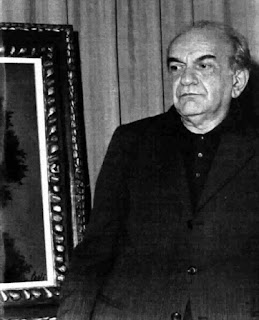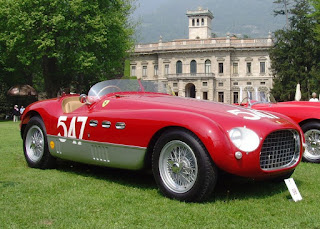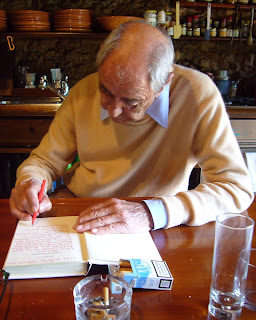Jewish artist who fought in World War II as a US soldier
 |
| Corrado Cagli, pictured in his studio in Rome in around 1969 |
He moved with his family to Rome in 1915 at the age of five and by the age of 17 had created his first significant work, a mural painted on a building in Via Sistina, the street that links Piazza Barberini with the Spanish Steps in the historic centre of the city.
The following year he painted another mural inside a palazzo on the Via del Vantaggio, not far from Piazza del Popolo. In 1932, he held his first personal exhibition at Rome’s Galleria d’Arte Moderna.
At this stage, despite being both Jewish and gay, Cagli had the support of the Fascist government, who commissioned him and others to produce mosaics and murals for public buildings.
Although he would go on to experiment in neo-Cubist style and metaphysical styles, the aim of the Scuola Romana he sought to establish with fellow artists such as Giuseppe Capogrossi and Emanuele Cavalli was to reaffirm the principles of classical and Renaissance art.
However, in 1938, when the Fascist dictator Benito Mussolini stepped up his persecution of Jews and other minorities, Cagli sought refuge in Paris and later fled to New York.
 |
| A detail from Cagli's 1936 painting, The Battle of San Martino, the final battle of the Second Italian War of Independence |
In fact, in an episode in his tour of duty that would have a profound effect on his life, he was part of a battalion that liberated Jewish prisoners from the Buchenwald concentration camp, near Weimar, in 1945. While he was there, Cagli made a series of dramatic drawings.
In 1948, Cagli finally returned to Rome to take up permanent residence again. At that time, he began to experiment in various abstract and non-figurative techniques, including metaphysical and neo-Cubist.
The recipient in 1946 of a Guggenheim award, in 1954 he was recognised with a Marzotto award, made by the Marzotto fashion company in Valdagno, in the Veneto between 1951 and 1968 to artists and thinkers who contributed to the cultural rebirth of Italy after the war.
In later life, he was the official banner painter for the Palio di Siena, the twice-yearly horse race around Siena’s Piazza del Campo, for which he had a particular fascination.
Corrado’s younger sister, Ebe, was a writer who also moved to the United States to escape Mussolini’s race laws. She married an academic, Abraham Seidenberg, and did not return to Italy.
Cagli died in Rome in 1976.
 |
| Ancona's Cathedral of San Ciriaco, which occupies an elevated position on the site of a former acropolis |
Ancona, where Cagli lived until he was five years old, is a bustling port with a population of almost 102,000, situated on the Adriatic coast in the Marche region. Although the area around the port has an industrial feel, there are some notable beaches nearby of which the Passetto is the best known. There is a good deal of history in the older part of the city, some of it bearing witness to its Greek and Roman past, as well as the Cathedral of San Ciriaco, which has mixed Romanesque-Byzantine and Gothic elements, and stands on a hill on the site of the former acropolis of the Greek city. The 18m-high Arch of Trajan, built in honour of the emperor who built the city’s harbour, is regarded as one of the finest Roman monuments in the Marche region. The harbour contains the Lazzaretto, a pentagonal building constructed on an artificial island in the 18th century as a quarantine station designed to protect the city from diseases carried by infected travellers.
Find accommodation in Ancona with Booking.com
 |
| Siena's beautiful Piazza del Campo, where the Palio di Siena horse race is staged on tow dates every summer |
The shell-shaped Piazza del Campo, established in the 13th century as an open marketplace on a sloping site between the three communities that eventually merged to form Siena, is regarded as one of Europe's finest medieval squares, looked over by the Palazzo Pubblico and the Torre del Mangia. The red brick paving, fanning out from the centre in nine sections, was put down in 1349. The Palio, which features 10 horses, each representing one of Siena's 17 contrade, or wards, ridden bareback by riders wearing the colours of the contrada they represent, was first contested in 1656 and is now staged on July 2 and August 16 each year.
More reading:
The founder of the scuola metafisica movement
Also on this day:
1821: The death of English Romantic poet John Keats
1822: The birth of archaeologist Giovanni Battista de Rossi
Home
Also on this day:
1822: The birth of archaeologist Giovanni Battista de Rossi
(Painting: The Battle of San Martino (1936), Uffizi, Florence)
(Picture credit: Piazza del Campo by Ricardo André Frantz via Wikimedia Commons)
Home





